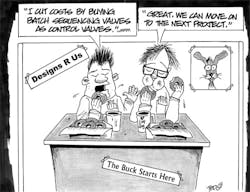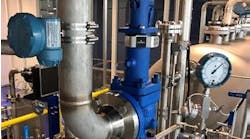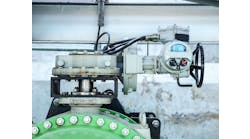Check out ControlGlobal.com on Google+
Greg: I have known James Beall way back to his days at Eastman Chemical when he generated some eye opening data on the response of valve positioners. James started out as instrument engineer. When James moved to the field he had to make the instrumentation and valves that he had selected actually work! This lead to a career in process control improvement at Eastman and his present position as principal consultant at Emerson. I have always been impressed with James field experience, practical approach, and open mind. In a way, I followed a similar path. When I first started at Monsanto, I was immediately transferred to Electrical and Instrument construction to install and commission what other engineers had selected. I learned what worked and didn't work. After my career at Monsanto and Solutia (now Eastman), I ended up as principal consultant as well but on a contract basis. At the end of December most of my contract work ends freeing me to relieve a knowledge overload in my head via overdue books. I have 4 books in the queue.Stan: Since automation systems generally affect the process by manipulating a flow, the control valve is the key final control element. What was the biggest step forward that helped you improve valve performance?
James: The biggest revelation was getting the actual valve or more accurately the "actuator" position into the data historian and my process control data analysis system. Before the advent of the high performance digital positioner with readback, we had to install temporary or permanent position transmitters.
Greg: I installed position transmitters on surge valves because it was essential for making sure the pres-stroke dead time less than a second and the stroking time less than 1 second. It would haven been helpful to have this indication for all control valves but the cost of the separate transmitter and wiring relegated the installation to special cases. Not knowing what the valve was actually doing led to creative explanations of process variability. The Control feature I wrote at an ISA conference in the early 1990s "Valve Position: The Missing Link" revealed the absurdity of the situation. The feature ended up as a chapter in the ISA book How to Become an Instrument Engineer - Part 1.523 coauthored with Monsanto engineers with a similar sense of humor.
James: Without actual valve position (AVP) in the data historian, it is particularly difficult to diagnose when a valve moves despite a steady signal. If something was strange, the first thing to do was plot the AVP. In one case the valve would move on its own at a certain spot in the piston due to a worn O-ring. In another case the valve cycle was following the instrument air compressor pressure cycle. We found there was no air pressure regulator for the valves but even so, after checking the positioner specifications, the double acting pistons should not have been moving. The real problem turned out to be that the cross-over pressure was set to zero so there was no stiffness except for the spring that assisted fail action. Since the pressure could not go below zero, the actuator was acting like a single acting rather than a double acting piston.
Stan: Can you figure out everything from the control room?
James: You always need to look at what is out in the field or it will bite you. Once on a level loop on a decanter boot, a relatively fast integrating process, showed a limit cycle indicating a deadband of about 1%. When we checked the valve in the field, the valve would respond to a 0.1% change in signal if you waited long enough, so technically the supplier could say the valve had a resolution of 0.1%. The positioner had a 2 stage relay. For changes larger than 1%, the high capacity relay would kick in and the valve would respond within a second or two. For smaller changes in signal the valve would take 40 seconds or more respond. The fast integrating loop effectively revealed the real resolution limit because the level was ramping while waiting for the valve to respond. We put on a digital valve controller (DVC) that is a high performance digital positioner and the problem went away. Since then I have recommended putting this type of positioners on all valves.
Greg: It seems a lot of poor performance can be related to suppliers and users not realizing that response time, deadband, and resolution are important. The ISA Standards ISA-75-25 sheds light on how to measure these metrics but stops at revealing the implications and providing guidelines for various applications. I got burnt big time in 1975 as lead engineer for the world's largest acrylonitrile plant when the contract design and construction firm said we could save big bucks by omitting positioners on several hundred loops. The lead engineer pulled out a Nyquist plot study from a supplier that showed positioners would hurt performance and if speed was needed a booster should be used instead of a positioner. During startup, I ended up putting positioners on all the valves because many did not move unless the signal changed by 25%. I got burnt again about ten years later when I tried to replace positioners with boosters on surge valves. The huge butterfly valves slammed shut when the compressor started. The instrument tech showed me how he could manually easily move the 24 inch butterfly valve by simply grasping the shaft. When the positioner was put on he could not budge the valve as you might expect. The high outlet port sensitivity of the booster led to positive feedback with the diaphragm actuator. A couple of years later at a factory acceptance test, the valve supplier made the same mistake. I went up to the 30 inch valves and showed how I could stroke them with my hand on the shaft.
James: Without a positioner, the deadband on a brand new valve in perfect condition can be anywhere from 5 to 25% and imperfect bench settings manifest themselves as offsets. I restated the old rule that "fast loops should not have positioners to "fast" loops have a chance to work satisfactorily without a positioner but will perform better with positioner, especially a modern DVC type positioner."
Greg: The main concern about the violation of the cascade rule where the valve positioner as a secondary loop needed to be faster than the flow loop as a primary loop was overstated because the flow loop was tuned with mostly reset action and not much gain action partly due to the unknown nonlinearity of the installed valve characteristic. The new positioners such as the DVC with excellent resolution can be tuned for exceptionally fast response. Also, external-reset feedback can be used if a fast position readback is available to prevent the burst of oscillations from the process loop output changing than the valve can respond allowing violation of the cascade rule.
Stan: What can go wrong with even a good valve, actuator, and positioner?
James: I once worked on a loop that had a "green" control valve with a DVC yet the data historian showed there was an 1/8% deadband. Normally I would have been happy with 1/8% dead band but the other "green" valves in the plant were doing better than this! When I went out in the field (remember, you will get burnt every time you do not go to the field!) I saw the feedback arm spring clip on the bonnet of the actuator. The feedback arm was missing its spring clip in the slot to rotate the positioner resulting in the observed backlash. The spring clip got knocked off. Someone realized the part belonged to the valve but didn't notify anyone.
Greg: Much worse is when the control valve and actuator are inherently a poor design and a DVC connected to the actuator shaft says everything is OK. The November 2012 Control feature article "Is your Control Valve an Imposter" gives the details of perhaps the greatest deception in the automation business.
James: In this case, a good "on-off" valve had been modified in an attempt to make it also provide throttling action. However, it wasn't performing well and was limiting production. Just 0.008 inch slack in the key ways of a shaft connection combined with the slop in a scotch yoke actuator caused an 8% deadband. The DVC feedback measurement was on the actuator shaft position before the backlash took effect. The DVC said things were not that bad. The addition of integral action in the positioner helped the slow level control loop do better. As a temporary fix, we made some mechanical modifications to the valve and actuator and then planned to replace the valve with a "real" regulating control valve at the first opportunity! When the new control valve was replaced, the process capacity could be increased by 10%!
Greg: The combination of the integrating response of the piston and in the positioner caused a fast limit cycle from actuator and valve dead band. I think the limit cycle average value from the filtering action of the process was closer to the desired position than the offset if there was no integral action in the positioner. Thankfully, the limit cycle wore out the valve. There is a quadruple whammy with the use of on-off rotary valve designed for tight shutoff as a control valve. Due to overcapacity the valve is operating near the seat where the sealing friction is the greatest. Since the translation of liner to rotary motion and shaft to stem connections were designed for open-close rather than throttling service, precision was not a consideration resulting in rampant backlash. The valve drop is a small fraction of the system drop causing a gross distortion of the inherent characteristic. To top it off the piston actuator has a poor threshold and is prone to o-ring problems. Adding insult to injury, the positioner is lying to you.
Stan: Given that you need to use a rotary valve what do you look for?
James: A diaphragm actuator, splined shaft connection, an offset of stem to closure member, low sealing friction, low packing friction, a contoured disk butterfly or segmented V-notch ball with an equal percentage characteristic, and rotary feedback of stem position to a high performance digital positioner. Surprisingly, there is a lot technology in the packing. A "Mom and Pop" service shop unbeknownst to us in plant put GraphoilTM packing, not made by the valve manufacturer, in a valve creating horrendous resolution (stiction). However, we ran diagnostics on the valve and the signature plot looked dandy - the full scale traverse of position did not reveal much of a resolution issue. Only when we slowed the ramp rate of the input signal during the signature test did we see the stair step response of stick and slip caused by poor resolution. Apparently the generic packing had a large difference between the static and dynamic friction coefficients causing the "stick and slip" issue and resulting poor control. The problem was solved by putting in the low friction high temperature packing from the control valve manufacturer that was carefully designed to have a small difference between the static and sliding friction coefficient. By the way, most pneumatic positioners can cause a limit cycle similar to the packing induced "stick-slip" but is actually caused by a slow response of the positioner when the valve position is "close" to the target. This problem is easily solved with a high performance digital poistioner that has a consistent (fast) speed of response for small changes.
Stan: Looks like another example of the consequences of poor valve dynamic performance not being commonly understood. If your service shop or control valve supplier cannot talk intelligently about response time, deadband (backlash), and resolution (stick-slip) you should look for one that can.
Greg: The positioner like any other controller performs only as good as the tuning. The pneumatic positioner was a proportional only controller with a gain of about 150. Today's positioner offers incredible flexibility and something akin to PID control. There is even a lead-lag to help make the rise time faster and overshoot smaller similar to the lead-lag advocated by Shinskey for the setpoint response in process PID controllers. How do you tune the DVC?
James: The DVC has recommended tuning sets for different actuator and valve combinations but many applications do not fit a set of rules just as in tuning process controllers. I first knock the heck out it maximizing the speed of response with proportional action. Often a positioner has a hidden gain multiplier, like 15, which means that a gain factor of 10 is effectively a proportional mode gain of 150. Once the valve is responding well, I reduce the overshoot with derivative action from the shaft position. The minor loop feedback helps by providing very fast motion control of the pneumatic relay kind of like a very fast inner loop. We still have a lot to learn about tuning positioners. In most applications I do not recommend integral action in the positioner.
Stan: What can users do to better understand stick-slip?
James: Static friction sets stick and dynamic friction determines slip. The static friction of tight shutoff rotary valves can be so large that there is shaft windup where the actuator shaft moves but the internal closure member (e.g., ball or disc) does not move. When the change in actuator torque becomes large enough, the shaft unwinds. We have seen as much as 1-2% shaft windup!
Greg: The plots I have seen show a stair step response indicating a slip. If the movement did not try to make up for lost ground but simply tracked a continuing change in the same direction, the response would be more like backlash. Both backlash and sticktion create a deadtime that is the deadband or resolution limit divided by the rate of change of the controller output.
Stan: What have you learned about the valve characteristics?
James: Gas pressure loops can benefit from a linear trim characteristic when the valve has a pressure drop that is much larger than other pressure drops or when the valve is operating at a critical pressure drop. Linear trim is desirable in these cases because the effective pressure drop available for the valve does not change with flow resulting in an installed flow characteristic that is close to the inherent flow characteristic. This is because the valve drop is so large compared to other pressure drops resulting in an installed characteristic close to the inherent characteristic. In general we need to pay attention to the change in the flow characteristic when the valve drop is small compared to frictional losses in the piping system.
Greg: I also recommend linear trim for reagent valves for pH control since the valve drop is the system drop. For most other loops, a linear inherent characteristic is undesirable because it distorts to a quick opening characteristic as the valve drop as a fraction of the system drop decreases. Today's emphasis on minimizing energy has taken a wrong term in allocating insufficient pressure drop to the control valve causing severe distortion and loss of rangeability.
Stan: Where do you like to do signal characterization to deal with the installed characteristic?
James: I prefer to do the characterization in the DCS so the linearization is more visible, flexible, and maintainable. Cascaded signal characterizers can be used to provide incredible resolution. The input and output of the signal characterizers can be clearly shown on the operator graphics. For split ranged outputs, the characterizers can be addressed for each valve. In some DCS's a "swap output parameter" is available in the characterizer block that provides another input to reverse the output to the input to provide the back calculate signal needed for bumpless PID action. Also, with characterization in the DCS, if the valve is changed out in the middle of the night, you don't have to worry about whether the positioner has the right characterization.
"Top Ten Signs Your Control Valve is an Imposter"
(10) The piping supplier says he has an incredible great deal to meet your control valve needs
(9) The valve supplier asks "What is deadband and resolution?"
(8) The valve looks suspiciously like the valve the operator uses for isolation
(7) The actuator looks suspiciously like the actuator on an on-off valve
(6) The packing is the same as used in the piping valves
(5) The leakage rate is phenomenally low
(4) You can standardize on parts in valves supplied with packaged equipment
(3) Integral action needs to be used in the positioner
(2) Loops oscillate regardless of tuning settings
(1) The positioner creed is "What Me Worry?"







